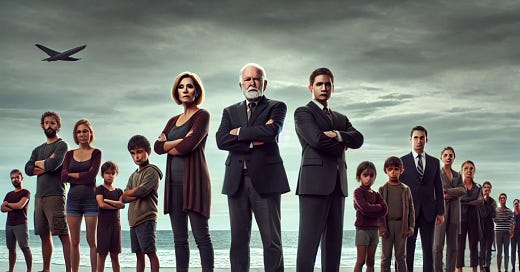Some people are like crustaceans—when they outgrow their shells due to personal growth, they retreat briefly to avoid predators before emerging with new, stronger armor that accommodates their expansion. Others, however, cling to familiarity like barnacles, resisting change and growing increasingly miserable as the world imposes itself upon them.
A key aspect of preparedness is defining your "line in the sand"—the point at which conditions become unacceptable and change is necessary. This line encompasses your work, living, financial, and social circumstances, as well as the threshold where you declare, "Enough is enough; I need change now."
It’s crucial to establish this boundary while in a rational and clear-headed state, rather than making impulsive decisions under duress that may not serve you in the long run. For some, the breaking point is shaped by religious or cultural values, morals, or deeply held personal beliefs. For others, it may be as tangible as their last dollar or an injury that pushed them to the brink.
Recent events in New York and the United Kingdom have become that breaking point for many, forcing them to confront their limits and decide what comes next.
When Your Job Turns Against You
As a native New Yorker & former Law Enforcement Officer, I can sympathize with my corrections officer brothers & sisters whom had their safety & health jeopardized by the HALT Act which passed in April 2022.
The Humane Alternatives to Long-Term Solitary Confinement (HALT) Act in New York introduced significant changes to the state's correctional system, aiming to limit the use of solitary confinement. However, certain provisions of the HALT Act led to concerns among corrections officers, contributing to a statewide strike. The key elements that prompted this action include:
1. Limitations on Solitary Confinement
Duration Restrictions: The HALT Act restricts the use of segregated confinement to a maximum of 15 consecutive days. Corrections officers argue that this limitation reduces the effectiveness of disciplinary measures, potentially compromising institutional safety.
Eligibility Criteria: The Act prohibits solitary confinement for specific vulnerable populations, including individuals under 21 or over 55, those with disabilities, pregnant individuals, and new mothers. Officers express concerns that these restrictions limit their ability to manage and discipline inmates effectively.
2. Increase in Workplace Violence
Safety Concerns: Officers report a rise in assaults and violent incidents within correctional facilities since the implementation of the HALT Act. They attribute this increase to the reduced deterrent effect of solitary confinement, leading to heightened safety risks for both staff and inmates.
Statewide Assaults: In the first year post-HALT Act implementation, there was a nearly 33% increase in combined assaults on staff and inmate-on-inmate incidents compared to the previous year. In the second year, these assaults rose by an additional 35%, culminating in a near doubling of such incidents over the two-year period.
Assaults on Staff: From 2019 to 2024, assaults on correction officers surged by 85%, highlighting escalating safety concerns within the facilities.
3. Staffing Shortages and Mandatory Overtime
Operational Challenges: The HALT Act's provisions have coincided with staffing shortages, resulting in mandatory overtime and extended shifts for corrections officers. This has led to increased fatigue and stress among staff, further exacerbating safety and operational concerns.
corrections1.com Before the recent strike, New York corrections officers were frequently subjected to mandatory overtime, with some shifts extending up to 24 hours.
Collectively, these factors contributed to the decision by corrections officers to initiate a strike, seeking revisions to the HALT Act and improvements in working conditions.
Would you work for an institution which allowed its customers to physically harm you with minimal recourse? Would you work for an institution which subjects you to mandatory overtime with shifts extending up to 24 hours? The natural response would be hell no! After nearly three years of dealing with more than double the amount of violence in addition to mandatory overtime, thousands of New York corrections officers drew their line on February 17th. “The strike has crippled operations at many state prisons and required more than 6,500 New York National Guard troops to be deployed to assist with security.” What were the National Guard’s accommodations? Jail cells. The National Guard is not trained to deal with prisoners in correctional facilities & their scope of work is limited to security (observation). During the strike, New York Governor Kathy Hochul suspended the health insurance coverage for not only the corrections officers but their families as well. Some retaliatory actions during the strike by Governor Hochul included:
The administration had refused to agree to retroactively restore health care benefits for employees.
The agreement struck Saturday (March 8th) defused that standoff and said the state will “reinstate, effective immediately and back to the first date of absence, the health insurance of any employee who had their health insurance terminated, so long as the employee pays the Cobra rate for such coverage for the period of termination and so long as the employee returns to work by the deadline and as set forth in (this agreement.)” (COBRA is a federal law that allows an employee to keep their health insurance — at their cost — after a job loss.)
Asking the attorney general’s office several days ago to begin pursuing criminal contempt charges against more than 1,000 correction officers. The corrections department said those actions would be withdrawn against officers who return to work by the deadline. Times Union
The corrections officers continued to strike until March 10th (only hundreds of supervisors thus far have returned) when some negotiations took place.
When the Justice System is Unfair
Chances are you aren’t a corrections officer & you’re wondering what it has to do with you. I will get to that point once I connect you with a similar story from the United Kingdom last week. New guidelines set to take effect on April 1, 2025 will introduce a two-tier justice system:
The United Kingdom's Sentencing Council recently issued new guidelines advising judges to consider an offender's ethnicity, faith, or gender during sentencing. This initiative aims to address disparities highlighted in the 2017 Lammy Review, which found significant racial biases in the UK's criminal justice system. en.wikipedia.org
Justice Secretary Shabana Mahmood has criticized these guidelines, arguing they could lead to a "two-tier justice system" favoring ethnic minorities and transgender individuals. She has summoned Council leaders to discuss her concerns and has threatened legislative action to oversee their decisions. The Sun
The Sentencing Council, led by Chairman Lord Justice William Davis, defends the guidelines, emphasizing judicial independence and the need to consider an offender's background to ensure fair sentencing. The Council has refused to retract the guidance despite governmental pressure. The Sun
The guidelines have sparked a cross-party backlash. Shadow Justice Secretary Robert Jenrick argues that they introduce bias against white individuals, men, and Christians, and has initiated legal proceedings to challenge them. The Conservative Sentencing Minister Gareth Bacon had approved the guidance in February 2024, highlighting ongoing controversy.
There is no doubt, like the HALT Act with prisoners inside the jail, the introduction of a two-tier justice system will encourage non-white, females, & people of ‘other’ than Christian faiths to increase their participation in criminal activity. Government data about the UK's different ethnic groups. 82% of people in England and Wales are white, and 18% belong to a black, Asian, mixed or other ethnic group (2021 Census data). That was in 2021. I’m sure mass migration has increased the percentage to well over 18%.
When Law & Order is no More
What do you think will happen to society if law & order is severely diminished? Sweden, a once thriving & relatively peaceful country, now has police no-go zones & areas dominated by Sharia law. In addition, gang-related violence has become extreme:
Monthly Incidents: Sweden is currently battling a wave of gang violence, often involving teenagers who are recruited by criminal networks to carry out violent acts, including vandalism, bombings and contract murder. In January 2025 alone, there were approximately 30 gang-related explosions reported in the country, often in residential areas and mostly concentrated in the capital Stockholm. Europarl
Comparative Data: In 2019, Sweden recorded 133 bombings.
Statista The recent surge suggests that the number of incidents in 2024 may have surpassed previous records.
U.S. cities like Oakland, California, Chicago, Illinois, & New York City, New York have seen crime skyrocket, businesses shutter, the streets fill with drug addicts. homeless, & gang members. No one feels safe when law enforcement is rendered powerless.
When You Cannot Defend Yourself or Your Property
Soon, you will be powerless. Even when someone violates your home & personal property. In California, Assembly Bill 1333 was introduced on Friday, February 21, 2025:
Assembly Bill 1333, which was introduced on Friday by 51st district Assemblyman and Democratic Caucus Chair, Rick Chavez Zbur, and here is what it says.
"This bill would eliminate certain circumstances under which homicide is justifiable, including, among others, in defense of a habitation or property. The bill would additionally clarify circumstances in which homicide is not justifiable, including, among others, when a person uses more force than necessary to defend against a danger."
"So the homeowner would have to determine within seconds or whatever, why a stranger suddenly showed up inside their house at any given hour before they could safely do anything to defend themselves.," Tangipa points out.
Not only that, says Tangipa, "...they would have to exercise all other options of, oh, well, you could have just run away. You could have jumped out the window, ... before using your deadly force to protect yourself in your own home, or protect your family, you have to prove that that was necessary to shoot somebody who broke into your house, and how do you prove that? "
Shifting the concern of proving self-defense to the homeowner while in the middle of a surprise attack.
"If that person has a bat, I almost have to allow them to hit me first to then prove that they had the intent to kill me", asserted Tangipa, "and that is unacceptable. And not only that, it steps on our 2nd amendment rights." If you can't be safe in your own home, where can you flee to?"
Tangipa says that's the part that makes this bill very dangerous in that it demonizes homeowners when lawmakers should really be going after the criminals breaking into homes.
Tangipa says the bill's author... assemblyman Rick Zbur, has already stated that it was not his intent to take away the right of self-defense, even though that is in the language.
Tangipa also says lawmakers are making amendments to the bill right now because of the amount of public backlash.
When Your Child’s Bodily Autonomy is at Stake
Let’s say you don’t live in or near a major city & you don’t think this affects you enough to draw the line. What about when you or your child’s bodily autonomy are at stake? On Monday, March 3rd, a Second Circuit panel ruled a New York State law requiring Amish students to receive vaccinations does not violate those students’ constitutional rights.
The case, which the panel heard this past November, had been brought by three Amish community schools that were fined in 2019 for failing to comply with state-mandated school vaccinations.
The schools and Amish parents argued their First and 14th Amendment rights had been violated, as many Amish seek to live separately from the modern world and abhor vaccines.
New York had since 1966 allowed exemptions from mandatory school immunization for medical reasons or sincerely held religious objections. However, following a nationwide measles outbreak in 2018 and 2019, the Legislature removed those exemptions, joining four other states to prohibit any kind of non-medical exemption.
Shortly after the new rule was passed, the Dygert Road School, Pleasant View school, and Shady Lane school were fined tens of thousands of dollars each for violating state law after they refused to comply with the law. The schools and several board members sued the state for an injunction.
In 2024, U.S. District Court Judge Elizabeth Wolford, a Barack Obama appointee, dismissed the complaint. She found the facts of the New York case were similar to another complaint heard in Connecticut that also had been thrown out on a finding of no constitutional violations.
In a 28-page ruling, the trio of Second Circuit judges upheld Wolford’s dismissal, citing the Connecticut case and also finding the New York law did not run afoul of a landmark U.S. Supreme Court ruling from the 1970s that prohibited compulsory education of Amish children past middle school.
The court found the analogy to the Wisconsin v. Yoder case incongruous, noting New York’s vaccine rule would not “forcibly remove Amish children from their community at the expense of the Amish faith or the Amish way of life.”
The court noted that medical exemptions are typically tailored to a specific immunization, while religious exemptions apply to all vaccines. “The religious exemption’s sweep had a far greater ability to undermine the State’s interest in preventing the spready of disease,” the court said in its per curiam opinion.
Further, allowing religious exemptions caused “clusters of low vaccination rates and an inability to achieve herd immunity in certain communities,” the court wrote. - Courthouse News
As of 2025, California, Connecticut, Maine, and New York are the four U.S. states that do not permit religious exemptions for vaccinations required for school attendance.
If you don’t have a choice regarding what you put into your body or your children’s bodies, what do you have control over? Where you live. Those who brush it off as ‘no big deal, vaccinations have been required seemingly forever to attend school’ don’t possess that personal barrier. If you’re a vegetarian & someone tells you that you have to eat meat to go to school in New York what are you going to do? Some may cave because it wasn’t a strongly held personal conviction but others simply will not compromise what they believe in &/or what their body will tolerate in order to participate in school. There are plenty of schools elsewhere.
When Your City is a Designated C40 Climate Leadership Group Target
Below is a breakdown of the member cities by region:
Africa:
Abidjan, Côte d'Ivoire
Accra, Ghana
Addis Ababa, Ethiopia
Cape Town, South Africa
Dakar, Senegal
Dar es Salaam, Tanzania
Durban, South Africa
Ekurhuleni, South Africa
Freetown, Sierra Leone
Johannesburg, South Africa
Lagos, Nigeria
Nairobi, Kenya
Tshwane, South Africa
East Asia:
Beijing, China
Chengdu, China
Dalian, China
Fuzhou, China
Guangzhou, China
Hangzhou, China
Hong Kong, China
Nanjing, China
Qingdao, China
Shanghai, China
Shenzhen, China
Wuhan, China
Zhenjiang, China
Tokyo, Japan
Yokohama, Japan
Seoul, South Korea
Europe:
Amsterdam, Netherlands
Athens, Greece
Barcelona, Spain
Berlin, Germany
Copenhagen, Denmark
Heidelberg, Germany
Istanbul, Turkey
Lisbon, Portugal
London, United Kingdom
Madrid, Spain
Milan, Italy
Moscow, Russia
Oslo, Norway
Paris, France
Rome, Italy
Rotterdam, Netherlands
Stockholm, Sweden
Venice, Italy
Warsaw, Poland
North America:
Austin, USA
Boston, USA
Chicago, USA
Guadalajara, Mexico
Houston, USA
Los Angeles, USA
Mexico City, Mexico
Miami, USA
Montreal, Canada
New Orleans, USA
New York City, USA
Philadelphia, USA
Phoenix, USA
Portland, USA
San Francisco, USA
Seattle, USA
Toronto, Canada
Vancouver, Canada
Washington, D.C., USA
South America:
Bogotá, Colombia
Buenos Aires, Argentina
Caracas, Venezuela
Curitiba, Brazil
Lima, Peru
Medellín, Colombia
Quito, Ecuador
Rio de Janeiro, Brazil
Salvador, Brazil
Santiago, Chile
São Paulo, Brazil
South and West Asia:
Ahmedabad, India
Amman, Jordan
Bengaluru, India
Chennai, India
Dhaka, Bangladesh
Dubai, UAE
Jaipur, India
Karachi, Pakistan
Kolkata, India
Mumbai, India
New Delhi, India
Tel Aviv, Israel
Southeast Asia & Oceania:
Auckland, New Zealand
Bangkok, Thailand
Hanoi, Vietnam
Ho Chi Minh City, Vietnam
If you’re in a C40 City, these are the aims of the agenda & you will likely get very uncomfortable:
1. Cutting Greenhouse Gas Emissions
Implementing net-zero carbon policies by 2050, with interim goals for 2030.
Reducing fossil fuel dependency by phasing out coal, oil, and natural gas in urban infrastructure.
Enforcing carbon budgets to ensure emission reductions align with the Paris Agreement.
2. Sustainable Transportation & Mobility
Expanding public transportation networks to reduce private vehicle use.
Banning fossil fuel cars in key city areas (e.g., London, Paris, and New York aim for zero-emission zones by 2030).
Promoting cycling and pedestrian-friendly infrastructure.
3. Green Energy & Buildings
Mandating energy-efficient building standards (e.g., retrofitting old buildings with better insulation and solar panels).
Expanding solar, wind, and hydroelectric energy projects to power urban centers.
Replacing gas heating systems with electric alternatives.
4. Reducing Waste & Promoting Circular Economy
Implementing zero waste goals by reducing food and plastic waste.
Banning single-use plastics and encouraging composting and recycling.
Creating circular economies, where waste is minimized through reuse and repurposing materials.
5. Improving Air Quality
Reducing industrial pollution by regulating emissions from factories.
Expanding urban green spaces (parks, tree planting) to absorb CO₂.
Monitoring air quality data to enforce clean air policies.
6. Resilience Against Climate Change
Preparing cities for rising sea levels through flood defenses (e.g., Venice & New York).
Developing heatwave mitigation strategies, including cooling centers and reflective roofs.
Strengthening disaster response to wildfires, hurricanes, and other climate-related crises.
7. Sustainable Food Systems & Diet Changes
Encouraging plant-based diets to reduce carbon footprints from livestock.
Supporting urban farming and local food production to cut transport emissions.
Partnering with businesses to reduce food waste in supermarkets and restaurants.
8. Global Collaboration & Policy Enforcement
Sharing successful climate policies among cities.
Holding corporations and governments accountable for sustainability goals.
Investing in climate-friendly technology and innovation.
Some will stay and fight for their fellow citizens. Others will pack up and leave. But if you leave, does the government win? And if you stay but remain silent because it doesn’t affect you, does your silence become compliance?
The totalitarian tiptoe is exactly that—a slow, calculated creep. Studies show that small concessions lead to bigger demands, each step pushing boundaries further. Remember “two weeks to stop the spread”? It led to masks, then vaccine mandates.
So ask yourself—where do you draw the line? When your freedom, health, or family’s safety is at stake, will you recognize the moment when “just one more step” becomes one step too far?
Consider sketching out decision trees that outline various scenarios affecting different aspects of your and your family’s lives—work, school, social/community, finances, health, and legacy. Encourage your significant other and any children 18 or older to do the same.
Once everyone has mapped out their individual plans, come together for a tabletop exercise, walking through each scenario. This process will reveal where you and your family are aligned and where compromises may be necessary.
It’s far better to have these discussions during a time of relative stability rather than being forced into rushed decisions under pressure. Additionally, some contingency plans can take months or even years to implement, depending on factors such as:
Knowing your finances & determine the amounts of money you would need to tide you over during short, medium, & potentially long-term transitions
Accessible, immediate, & portable emergency funds both in fiat currency & gold/silver
Accessible, immediate, & portable food, water, shelter, medication, & sanitary needs for you & members of your immediate family
Rapid deployment methods for catastrophic events to include bug-out bags, vehicles, & E-bikes.
Moving expenses & methods for more permanent transitions
Passports, visas, understanding the various paths toward citizenship &/or longer-term visas
Scouting a Plan B location, boots-on-the-ground research on cost of living, politics, & ease of expatriation
Alternative employment opportunities & alternative educational opportunities for children
Setting up an alternative homestead to include off-grid or more self-sustainable living
There’s a lot more to consider, but this is a solid starting point—and an essential conversation to have with those you care about. Natural or man-made disasters can strike without warning, and being prepared is never a wasted effort. You'll never regret the time, money, or energy invested in readiness.
Until next time my fellow Warriors, stay informed, stay vigilant, Ever Forward!








